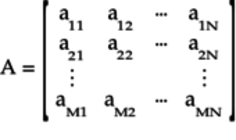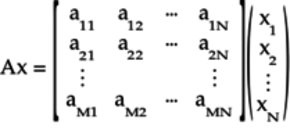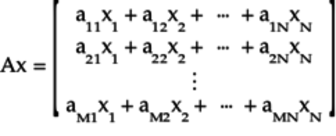Working with Matrices and Vectors
In quantum mechanics, we frequently multiply matrices as well as matrices with vectors. As shown in "Fundamental Theorem of Linear Algebra" [Str93], although the mechanics of these types of multiplications may seem arbitrary, they offer a point of view that gives us a way to represent the operation of gates on quantum states. (For a lucid description of linear algebra in a practical setting, especially the discussion relating to the columns of a matrix, which is of the most interest to us, see Foundations of Network Optimization and Games [FB16].)
A matrix is an array of numbers arranged as follows:

In this matrix, the numbers are organized in two rows and two columns. Although in quantum computing we’ll deal with square matrices in which the number of rows are the same as that for columns, here we’ll work with rectangular matrices, where the number of rows differs from that for columns, to emphasize that there’s nothing special about square matrices in this regard.
It’ll be more instructive to talk about matrices whose elements are represented symbolically, as shown here:

(The “![]() ” is just a
shortcut to indicate that the matrix contains
other elements or numbers that are labeled in the
same way.)
The elements, or numbers,
” is just a
shortcut to indicate that the matrix contains
other elements or numbers that are labeled in the
same way.)
The elements, or numbers,
![]() , where
, where ![]() and
and ![]() ,
of the matrix are laid out in an
array of
,
of the matrix are laid out in an
array of ![]() rows and
rows and ![]() columns.
The first subscript
columns.
The first subscript ![]() is the index of the
row, and the second subscript
is the index of the
row, and the second subscript ![]() is the index
of the column in the array.
Thus, the element
is the index
of the column in the array.
Thus, the element ![]() refers to the number
in the first row and second column of the matrix.
The number of rows and columns of the array are the dimensions
of the matrix, which we’ll write as
refers to the number
in the first row and second column of the matrix.
The number of rows and columns of the array are the dimensions
of the matrix, which we’ll write as ![]() .
.
A vector ![]() is a matrix
with just one column:
is a matrix
with just one column:

This vector has ![]() rows or elements and
is an
rows or elements and
is an ![]() vector.
vector.
Multiplying the ![]() matrix
matrix
![]() with the
with the ![]() vector
vector ![]() , we get:
, we get:

The product will be an ![]() vector
of
vector
of ![]() elements, as shown here:
elements, as shown here:

Each element in this vector is obtained by
multiplying term-by-term the ![]() -th
row with the elements of the vector
-th
row with the elements of the vector ![]() .
Thus, for the second element in this vector,
we multiplied each term in the second row
with the corresponding elements in the
.
Thus, for the second element in this vector,
we multiplied each term in the second row
with the corresponding elements in the
![]() vector.
(Because each term in a row of the matrix
vector.
(Because each term in a row of the matrix ![]() is multiplied by the corresponding element in the
vector
is multiplied by the corresponding element in the
vector ![]() , the number of columns in
the matrix
, the number of columns in
the matrix ![]() has to equal the number of
elements of the vector
has to equal the number of
elements of the vector ![]() .)
.)
Key Step
The critical step is to group the
terms associated with each ![]() ,
,
![]() as a sum of vectors, as follows:
as a sum of vectors, as follows:

Each column of the matrix is multiplied by the
corresponding element of the vector ![]() .
In other words, vectors can be interpreted as a
way of extracting just the column we want from a matrix.
.
In other words, vectors can be interpreted as a
way of extracting just the column we want from a matrix.
To see how vectors act like column
selectors, consider the following
![]() vector whose second element
is a 1, and the others are 0:
vector whose second element
is a 1, and the others are 0:

Substituting this vector in the previous equation, we get:

That is, only the second column is multiplied
by 1, the other columns are multiplied by 0.
In other words, we have effectively pulled
out the second column of the matrix ![]() .
.
Multiplying Matrices
The idea of using vectors as selectors can be applied to multiplying matrices as well:
- Treat the second matrix as a collection of columns or vectors.
- Then, obtain each column of the product by multiplying the first matrix by the corresponding column of the second matrix.
For example, suppose you’re multiplying the following matrices:

Think of the second matrix as a collection of the following columns or vectors:

The first column of the product is:

The second column of the product is:

To get the product of the matrices, put the two columns together:

If you’re not in the business of multiplying matrices, the method described here may be at odds with the traditional way in which each element of the product matrix is calculated by doing an element-by-element multiplication of each row of the first matrix by each column of the second matrix and then summing each individual multiplication. The method described in this section moves the focus from individual elements and puts the emphasis on columns, a view that mathematicians prefer, as it gives a physical interpretation instead of merely a bunch of calculations. You’ll find this meaning of the vector for the qubits as a column selector more fitting when modeling quantum gates and analyzing quantum circuits.
Footnotes
- [105]
-
Complex numbers: https://en.wikipedia.org/wiki/Complex_number, https://en.wikipedia.org/wiki/Complex_conjugate and https://en.wikipedia.org/wiki/Euler%27s_formula#Applications_in_complex_number_theory.
- [106]
-
Trigonometric identities: https://en.wikipedia.org/wiki/List_of_trigonometric_identities
- [107]
- [108]
- [109]
- [110]

